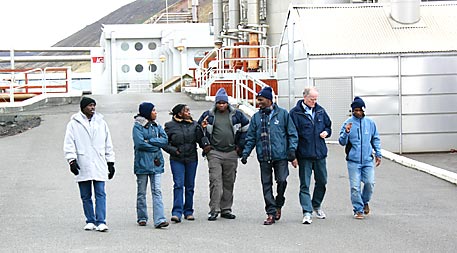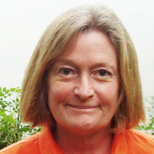January 3, 2013 — “Drill, baby, drill”? Well, yes, if it’s geothermal energy you need. Two quite different countries—Iceland and Kenya—are circulating their expertise to do so.
It may seem a truly odd connection. But the two countries are cousins under the skin, geologically speaking. Both experience active splits, or “rifts,” of the Earth’s crust, probably caused by “hot spot” tectonic forces below the crust in our planet’s mantle.
Kenya is underlain by the East African Rift. The rift’s two separated sides slice the country roughly north to south. To make these fissure walls, the Earth’s crust cracked, basaltic magma flooded out to pile up, and the expanded area between stretched and flattened. The rifting is still a work in progress, and today a dozen or so active or semiactive volcanoes keep the crust warmed. Kenya has become the first African country to exploit the energy potential of its geology, through two national companies actively drilling to release steam that can be used to create electricity.
The country gets about 26 percent of its electricity from geothermal heat created by the formation of the Earth and the radioactive decay of its minerals.
Iceland lies atop a rift, too: the vast Mid-Atlantic Rift. If the Earth were a baseball, this rift would be the stitching from the Arctic to Antarctica. Stretching at the stitched seams has created the Atlantic Ocean—and the island of Iceland itself, as basaltic rock flowing out of the fissure piled up to break the ocean’s surface. Rifting is still active here, too, and the high rate of volcanic activity feeds the areas where five major geothermal plants pump up hot water.
“Iceland has had 40 confirmed eruptions in the last 19 years, more than is usually known,” says Páll Einarsson, professor of geophysics at the University of Iceland. The country gets about 26 percent of its electricity from geothermal heat created by the formation of the Earth and the radioactive decay of its minerals. Earth’s warmth is used mainly as hot water for heating, with some of the heat used to turn turbines that produce electricity.

Fellows participating in the 2011 United Nations University geothermal training program tour the Svartsengi plant. Photo by Ingimar G. Haraldsson.
Iceland’s long-time expertise with geothermal energy and drilling—the wells here are 1 to 2 kilometers or so deep—is being tapped by the United Nations. The United Nations University started a geothermal training program in Iceland in 1979. To date, 515 postgraduate scientists and engineers from 50 developing countries have come for six months of specialized geothermal energy training. The program includes background on geological exploration, borehole geology, the chemistry of thermal liquids and drilling technology. The training is managed by a “Geothermal Cluster” of about 80 institutions that mapped the country’s geothermal resources, keep its development focused and export its expertise.
Among those trained in Iceland was Pacifica Ogola from Nairobi. An environmental scientist with KenGen, Kenya’s major power company, Ogola sent a picture home of herself in a parka, grinning, amid plumes of geothermal steam. It was taken in 2009, when she returned to Iceland after her initial training to pursue a Ph.D. in geothermal technology. The sharing goes both ways: In March 2013, Iceland will host a geothermal conference at which Kenyans will be among the speakers.
Kenya’s goal is to get 5,000 megawatts of electricity—about one-third of its needs—from 566 geothermal wells by 2031. The country has used hydropower effectively, but persistent drought has necessitated power rationing. According to Ludvik Georgsson, deputy director of the UN program in Iceland, Kenya has almost 100 geothermal wells producing more than 200 MW of geothermal power.
Geothermal development in the broader Rift Valley of Africa (about six countries) is boosted by funds from the African Development Bank, World Bank, U.S. government, European Invest-ment Bank, French Development Agency and Kenya’s own funds. In Iceland, private companies such as Reykjavik Geothermal and Gekon, as well as the public organization ISOR, are important players. ISOR has had many geothermal projects in East Africa, as well as around the world.
As Kenya develops its geothermal energy resource with Iceland’s help, the downside of geothermal is receiving attention, too. The steam contains some carbon dioxide and hydrogen sulfide. So far, Kenya is able to use some of the sulfurs to tan hides and some carbon dioxide to boost flower production. Iceland has plans for a methanol fuel plant to use the carbon dioxide from one of its wells and to pump carbon dioxide into Iceland’s porous basalt rock, where the resulting seltzer will make solid limestone.
Though Iceland and Kenya are more than 5,400 miles apart, their connection reflects “one field where Icelanders have expertise and can be useful to others,” says Einarsson.
This article originally appeared in the Fall 2012 issue of Momentum magazine, Ensia’s predecessor, as “Steam Team.”
Ensia shares solutions-focused stories free of charge through our online magazine and partner media. That means audiences around the world have ready access to stories that can — and do — help them shape a better future. If you value our work, please show your support today.
Yes, I'll support Ensia!
